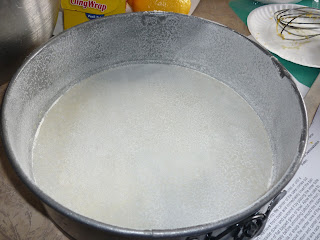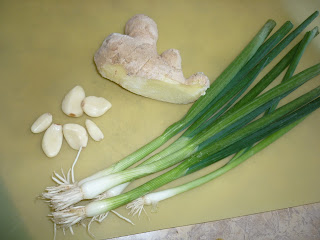(I forgot to take a final picture! This would have cream on top too)
I made this cake for work. We were having a competition and had to make a dessert that was "citrus" inspired. So, I made this with out the frosting and with out the coconut. It has a really nice lemon flavored curd and the cake has a wonderful flavor all on it's own. Next time I am going to make it all according to the recipe because I think that will turn out more complete.
Lemon Curd:
3 large eggs
1/3 cup (80 ml) fresh lemon juice (2-3 lemons)
1 tablespoon finely shredded lemon zest
3/4 cup (150 grams) granulated white sugar
Coconut Cake:
6 large eggs
2 1/2 cups (325 grams) all purpose flour
2 teaspoons baking powder
1/2 teaspoon baking soda
1/2 teaspoon salt
3/4 cup (170 grams) unsalted butter, room temp.
1 3/4 cups (350 grams) white sugar, divided
1 teaspoon pure vanilla extract
1 3/4 cups (420 ml) buttermilk
1/2 teaspoon cream of tartar
Frosting:
2 large (60 grams) egg whites
1 1/2 cups (300 grams) granulated white sugar
1/4 cup (60 ml) cold water
1 tablespoon light corn syrup
1 teaspoon pure vanilla extract
Lemon Curd: In a stainless steel bowl placed over a saucepan of simmering water, whisk together the eggs, sugar, and lemon juice until blended. Cook, stirring constantly (to prevent it from curdling), until the mixture becomes thick (like sour cream) (160 degrees F) (71 degrees C). This takes about 10 minutes. Remove from heat and immediately pour through a fine strainer to remove any lumps. Cut the butter into small pieces and whisk into the mixture until the butter has melted. Add the lemon zest and let cool. The lemon curd will continue to thicken as it cools. Cover immediately (so a skin doesn't form) and refrigerate until cold. The lemon curd can be made several days in advance.
Preheat oven to 350 degrees F (177 degrees C). Butter and flour two - 9 inch x 1 1/2 inch (23 x 3.75 cm) cake pans, and then line the bottoms with parchment paper.
Cake: While the eggs are still cold separate the eggs, placing the yolks in one bowl and the whites in another bowl. Cover the two bowls with plastic wrap and allow the eggs to come to room temperature before using (about 30 minutes).
In a mixing bowl sift or whisk together the flour, baking powder, baking soda, and salt.
In a mixing bowl sift or whisk together the flour, baking powder, baking soda, and salt.
In bowl of electric mixer, or with a hand mixer, beat the butter until soft (about 1-2 minutes). Gradually add 1 1/2 cups (300 grams) of the sugar and beat until light and fluffy (about 2-3 minutes). Add the egg yolks, one at a time, beating well after each addition. Scrape down the sides of the bowl. Add the vanilla extract and beat until combined. With the mixer on low speed, alternately add the flour mixture and buttermilk, in three additions, beginning and ending with the flour.
In a clean bowl of your electric mixer, with the whisk attachment, (or with a hand mixer) beat the egg whites until foamy. Add the cream of tartar and continue beating until soft peaks form. Gradually add the remaining 1/4 cup (50 grams) of sugar and continue to beat until stiff peaks form. With a rubber spatula gently fold a little of the whites into the batter to lighten it, and then fold in the remaining whites until combined. Do not over mix the batter or it will deflate.
Divide the batter and pour into the prepared pans, smoothing the surface with an offset spatula or the back of a spoon. Bake for about 35 to 40 minutes or until a toothpick inserted into the center of the cake comes out clean and the cake springs back when pressed lightly in center. Place the cakes on a wire rack to cool, in their pans, for about 10 minutes. Then invert the cakes onto a greased rack. To prevent splitting, re-invert cakes so that tops are right side up. Cool completely before filling and frosting.
( I didn't make the frosting this time, but probably will next time)
Frosting: In a stainless steel bowl over a saucepan of simmering water, place the egg whites, sugar, water, and corn syrup. With a handheld electric mixer beat the mixture for 3 to 4 minutes on low speed. Increase the speed to high and continue to beat for another 3 to 4 minutes or until the icing is shiny and satiny with soft peaks. Remove from heat, add the vanilla extract, and continue to beat on high speed for another 1 to 2 minutes or until the frosting is thick. Use immediately.
Assemble: With a serrated knife, cut each cake layer in half, horizontally. Place one cake layer on your serving plate and spread with about 1/3 of the lemon curd and sprinkle with about 2 tablespoons of coconut. Continue with the next layers, stacking and filling with the lemon curd and coconut. Frost the top and sides of the cake with the 7-Minute Frosting and then sprinkle with about 1 cup (240 ml) of coconut. Cover and refrigerate the cake until serving time. Makes one - 9 inch (23 cm) layer cake






















+Chocolate+Mousse+Dacquoise.jpg)
